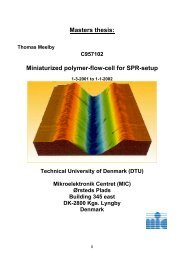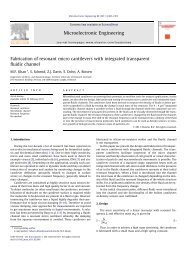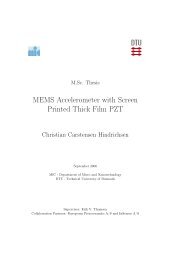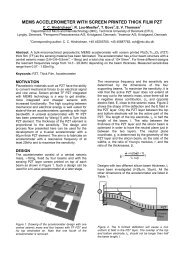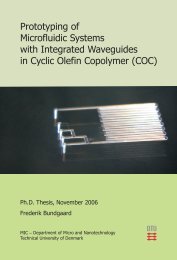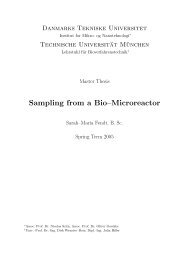Development of a Oxygen Sensor for Marine ... - DTU Nanotech
Development of a Oxygen Sensor for Marine ... - DTU Nanotech
Development of a Oxygen Sensor for Marine ... - DTU Nanotech
You also want an ePaper? Increase the reach of your titles
YUMPU automatically turns print PDFs into web optimized ePapers that Google loves.
42 CHAPTER 5. FABRICATION<br />
used is mainly that it is faster, basically it have a faster growth rate, and<br />
that the chip doesn’t require the higher breakdown voltage <strong>of</strong> dry oxidation.<br />
Figure 5.2: A layer <strong>of</strong> Silicon Dioxide have been added.<br />
Silicide Layer<br />
Next comes the Silicide layer, the silicide is going to serve as the conduction<br />
layer, between the actual sensor and the contacts. Silicide 2 (or rather<br />
TiSi2), resistivity <strong>of</strong> 13-16mΩcm is well suited <strong>for</strong> this due to its low resistivity.<br />
Which is an advantage since the finished Clark <strong>Sensor</strong> have to have<br />
an internal power supply, due to the sensor being attached to a fish, where<br />
the battery cannot be exchanged as one see fit.<br />
Figure 5.3: Illustration <strong>of</strong> the wafer after the silicide step.<br />
The Silicide layer is created by first depositing a layer <strong>of</strong> undoped Polysilicon<br />
with Low Pressure Chemical Vapor Deposition (LPCVD). It is also at<br />
this point the first alignments marks are made (See Figure 5.6). After this a<br />
Titanium layer is deposited on top <strong>of</strong> the Polysilicon, which is the patterned<br />
as well. Finally by using Rapid Thermal Annealing (RTA), the desired TiSi2<br />
is made.<br />
2 The silicide recipe is in Appendix A



